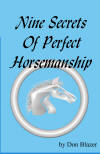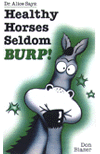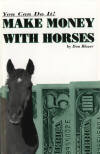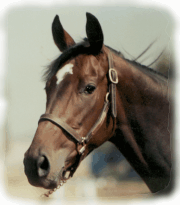
Don Blazer
Archives:
Flying Horses?
Don't eat like a Pig
Parasites
Back Sore?
Goat Hero
Communication
Foals
History of Horses
Jumping Horses
Lameness and Health
Kick the IRS
Meet Don Blazer
Books by Don Blazer
View Our Catalog
Secure Book Order Form
Don Blazer
A Horse, Of Course
Secure Book Order Form
Order using our Secure Order Form

Walter (A Horse, of Course) Spills the Oats
Nine Secrets of Perfect Horsemanship
This is a Secure Web Site
Archives:
Flying Horses?
Don't eat like a Pig
Parasites
Back Sore?
Goat Hero
Communication
Foals
History of Horses
Jumping Horses
Lameness and Health
Kick the IRS
Order using our Secure Order Form
View Our Catalog
This is a Secure Web Site
|
If he eats like a horse, thatís good.
If he eats like a pig, thatís not so good.
Horses eat a lot, but they donít devour their food. They are sort of gentile; they arenít sloppy. They take small bites not chunks, and they chew their food properly. And if they had napkins, theyíd use them.
When horses eat like pigs, gobbling their food down as fast as they can, slopping it all over the place, itís a sure bet something is wrong.
Most often, the thing that is wrong is that the horse isnít being fed like a horse. He isnít getting enough to eat and he isnít getting his food over a long enough period of time.
Horses are big and they are supposed to eat a lot. But horses are also grazing animals and so they are supposed to eat small amounts almost continually. In fact, a horseís stomach is small for his size, so it should be receiving small amounts of food rather than being stuffed.
But most horses donít get to graze all day and night, so if we want our horse to eat like a horse, we need to develop an eat-like-a-horse feeding program.
Throwing a flake of hay over the corral fence twice a day just wonít get it.
First we need to know how much nutrition our horse needs.
Itís pretty well agreed a horse doing light work will need at least two per cent of his body weight daily in high nutrition feed in order to maintain his condition.
A l,000 pound horse, doing light work, should be getting about 20 pounds of hay (alfalfa or grass) per day. This feed should be given in small amounts several times per day. The first feeding should be early--as soon as you get up. A second feeding can be made before leaving for the dayís activities. Try to get a third feeding in around noon, a fourth feeding at dinner time, and a final feeding just before you go to bed. It can be done, but if you choose not to, then feed as often as you think is possible.
A mature performance horse needs a protein level of about 12 per cent daily and he should get it from a normal feeding of alfalfa or clover.
Both are high in protein. If the horse is on a hay low in protein, then
increase the amount of hay being given to insure sufficient protein.
Lactating mares, foals and young growing horses have a higher
protein need. A mare and nursing foal should have a 20 per cent protein level, while weanlings should be on about a 15 to 18 per cent level. Two and three-year-olds need about 14 per cent protein level.
Horses getting more protein than needed will show it in a high
energy attitude, or in high water consumption and frequent urination. Replace some of the alfalfa or clover with a lower protein grass hay.
It is nearly impossible for most of us to determine protein levels in hay, so do the next best thing, buy high quality from hay dealers you know and can trust.
What you decide to do about grains (or concentrates) will be
determined by your horse and just how much performance energy he needs.
Determine the amount of grain to be fed by the amount of digestible energy desired. For example, corn can be fed in much smaller volume than oats because it has a much higher amount of digestible energy.
Some horses should be on low energy diets while others need to be on high energy rations. You have to make the determination.
Hereís a way to start. A 1,000 pound horse being worked lightly and getting 15 pounds of hay per day can get five pounds of oats per day.
After 15 to 30 days, you decide how satisfied you are with the horseís
energy level and desire to perform. Make your grain adjustments
accordingly.
Buy good quality grains from feed dealers and producers you trust.
Before adding any feed supplements be sure you have a confirmed
dietary deficiency.
Vitamins do not provide energy, but act as a catalyst, regulating the horseís ability to utilize other nutrients. Most horses will get all the vitamins they need in a feeding program utilizing both hays and grains.
If, however, you think vitamins are needed, consult your veterinarian
first.
Salt may be the only mineral youíll need to add to your horseís
diet. The average horse needs 50 to 60 grams of salt per day, and will appreciate salt supplementation.
Plenty of cool, clear water rounds out the feeding program. Be sure your horse always has water available. If, on occasion, this is impossible, be sure to water before feeding.
Hey, small amounts of hay or grass often, and your horse will be eating like a horse.
Each month you'll find a new column on our web site. We hope you'll enjoy it, and maybe
e-mail us with questions or suggestions for other
columns. A Horse, Of Course is a weekly column syndicated
by Success Is Easy. If you like the column, call your local newspaper, or local horse
publication and ask them to subscribe by contacting Success Is Easy, 13610 N. Scottsdale Rd., Suite 10-406, Scottsdale, AZ 85254
________________________________
A Horse Of Course |
Horse Books Catalog |
Meet Don Blazer
Ask Don Blazer |
Courses and Clinics |
Horse Training
Horses for Sale |
Who's Walter? |
Horse Links
Home
Info@donblazer.com
Copyright © 2000 by
Don Blazer
Success Is Easy, 13610 N. Scottsdale Rd., Suite 10-406, Scottsdale, AZ 85254
Vanndal Web Designs


